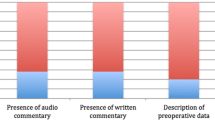Abstract
Background
In the current era, trainees frequently use unvetted online resources for their own education, including viewing surgical videos on YouTube. While operative videos are an important resource in surgical education, YouTube content is not selected or organized by quality but instead is ranked by popularity and other factors. This creates a potential for videos that feature poor technique or critical safety violations to become the most viewed for a given procedure.
Methods
A YouTube search for “Laparoscopic cholecystectomy” was performed. Search results were screened to exclude animations and lectures; the top ten operative videos were evaluated. Three reviewers independently analyzed each of the 10 videos. Technical skill was rated using the GOALS score. Establishment of a critical view of safety (CVS) was scored according to CVS “doublet view” score, where a score of ≥5 points (out of 6) is considered satisfactory. Videos were also screened for safety concerns not listed by the previous tools.
Results
Median competence score was 8 (±1.76) and difficulty was 2 (±1.8). GOALS score median was 18 (±3.4). Only one video achieved adequate critical view of safety; median CVS score was 2 (range 0–6). Five videos were noted to have other potentially dangerous safety violations, including placing hot ultrasonic shears on the duodenum, non-clipping of the cystic artery, blind dissection in the hepatocystic triangle, and damage to the liver capsule.
Conclusions
Top ranked laparoscopic cholecystectomy videos on YouTube show suboptimal technique with half of videos demonstrating concerning maneuvers and only one in ten having an adequate critical view of safety. While observing operative videos can be an important learning tool, surgical educators should be aware of the low quality of popular videos on YouTube. Dissemination of high-quality content on video sharing platforms should be a priority for surgical societies.

Similar content being viewed by others
References
McGee JB, Begg M (2009) What medical educators need to know about “Web 2.0”. Med Teach 30:164–169. doi:10.1080/01421590701881673
Pugh CM, Watson A, Bell RH, Brasel KJ, Purcell Jackson G, Weber SM, Kao LS (2009) Surgical education in the internet era. J Surg Res 156:177–182. doi:10.1016/j.jss.2009.03.021
Rapp AK, Healy MG, Charlton ME, Keith JN, Rosenbaum ME, Kapadia MR (2016) YouTube is the most frequently used educational video source for surgical preparation. J Surg Educ 73:1072–1076. doi:10.1016/j.jsurg.2016.04.024
Topps D, Helmer J, Ellaway R (2013) YouTube as a platform for publishing clinical skills training videos. Acad Med 88:192–197. doi:10.1097/ACM.0b013e31827c5352
Frongia G, Mehrabi A, Fonouni H, Rennert H, Golriz M, Günther P (2016) YouTube as a potential training resource for laparoscopic fundoplication. J Surg Educ 73:1066–1071. doi:10.1016/j.jsurg.2016.04.025
Fischer J, Geurts J, Valderrabano V, Hügle T (2013) Educational quality of YouTube videos on knee arthrocentesis. J Clin Rheumatol 19:373–376. doi:10.1097/RHU.0b013e3182a69fb2
Vassiliou MC, Feldman LS, Andrew CG, Bergman S, Leffondré K, Stanbridge D, Fried GM (2005) A global assessment tool for evaluation of intraoperative laparoscopic skills. Am J Surg 190:107–113. doi:10.1016/j.amjsurg.2005.04.004
Sanford DE, Strasberg SM (2014) A simple effective method for generation of a permanent record of the critical view of safety during laparoscopic cholecystectomy by intraoperative “Doublet” photography. J Am Coll Surg 218:170–178. doi:10.1016/j.jamcollsurg.2013.11.003
Kurashima Y, Feldman LS, Al-Sabah S, Kaneva PA, Fried GM, Vassiliou MC (2011) A tool for training and evaluation of laparoscopic inguinal hernia repair: the Global Operative assessment of laparoscopic skills-groin hernia (GOALS-GH). Am J Surg 201:54–61. doi:10.1016/j.amjsurg.2010.09.006
Hogle NJ, Liu Y, Ogden RT, Fowler DL (2014) Evaluation of surgical fellows’ laparoscopic performance using global operative assessment of laparoscopic skills (GOALS). Surg Endosc 28:1284–1290. doi:10.1007/s00464-013-3324-6
Kramp KH, van Det MJ, Hoff C, Lamme B, Veeger NJGM, Pierie J-PEN (2015) Validity and reliability of global operative assessment of laparoscopic skills (GOALS) in novice trainees performing a laparoscopic cholecystectomy. J Surg Educ 72:351–358. doi:10.1016/j.jsurg.2014.08.006
Bellorin O, Kundel A, Sharma S, Ramirez-Valderrama A, Lee P (2016) Training model for laparoscopic Heller and Dor fundoplication: a tool for laparoscopic skills training and assessment-construct validity using the GOALS score. Surg Endosc 30:3654–3660. doi:10.1007/s00464-015-4617-8
Gumbs AA, Hogle NJ, Fowler DL (2007) Evaluation of resident laparoscopic performance using global operative assessment of laparoscopic skills. Journal Am Coll Surg 204:308–313. doi:10.1016/j.jamcollsurg.2006.11.010
Deal SB, Lendvay TS, Haque MI, Brand T, Comstock B, Warren J, Alseidi A (2016) Crowd-sourced assessment of technical skills: an opportunity for improvement in the assessment of laparoscopic surgical skills. Am J Surg 211:398–404. doi:10.1016/j.amjsurg.2015.09.005
Buddingh KT, Nieuwenhuijs VB, van Buuren L, Hulscher JBF, de Jong JS, van Dam GM (2011) Intraoperative assessment of biliary anatomy for prevention of bile duct injury: a review of current and future patient safety interventions. Surg Endosc 25:2449–2461. doi:10.1007/s00464-011-1639-8
Pucher PH, Brunt LM, Fanelli RD, Asbun HJ, Aggarwal R (2015) SAGES expert Delphi consensus: critical factors for safe surgical practice in laparoscopic cholecystectomy. Surg Endosc 29:1–12. doi:10.1007/s00464-015-4079-z
Wauben LSGL, Grevenstein WMUV, Goossens RHM, der Meulen FHV, Lange JF (2011) Operative notes do not reflect reality in laparoscopic cholecystectomy. Br J Surg 98:1431–1436. doi:10.1002/bjs.7576
Satava RM (2004) Disruptive visions: surgical education. Surg Endosc 18:1–3. doi:10.1007/s00464-003-8224-8
Author information
Authors and Affiliations
Corresponding author
Ethics declarations
Disclosures
H. Alejandro Rodriguez, Monica T. Young, Hope T. Jackson, Brant K. Oelschlager, and Andrew S. Wright declared that they have no competing interests or financial ties to disclose with regards to this work.
Rights and permissions
About this article
Cite this article
Rodriguez, H.A., Young, M.T., Jackson, H.T. et al. Viewer discretion advised: is YouTube a friend or foe in surgical education?. Surg Endosc 32, 1724–1728 (2018). https://doi.org/10.1007/s00464-017-5853-x
Received:
Accepted:
Published:
Issue Date:
DOI: https://doi.org/10.1007/s00464-017-5853-x




